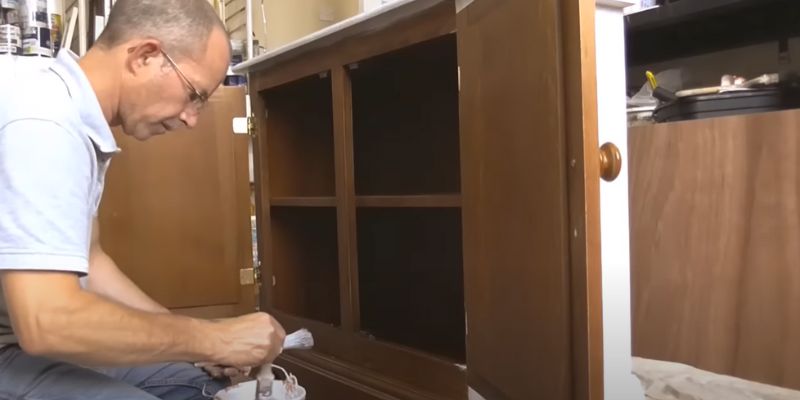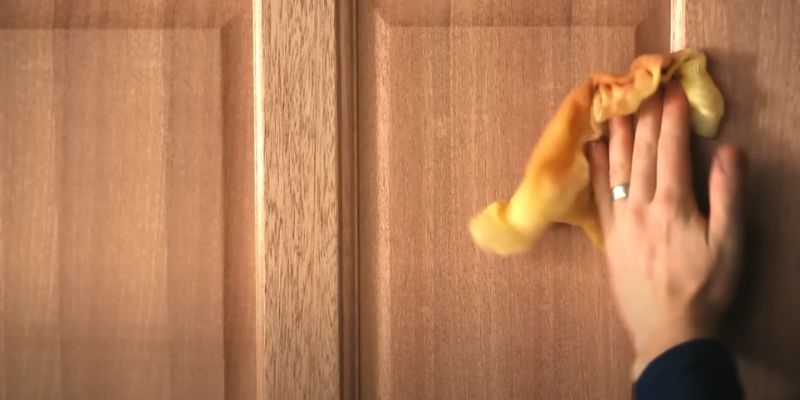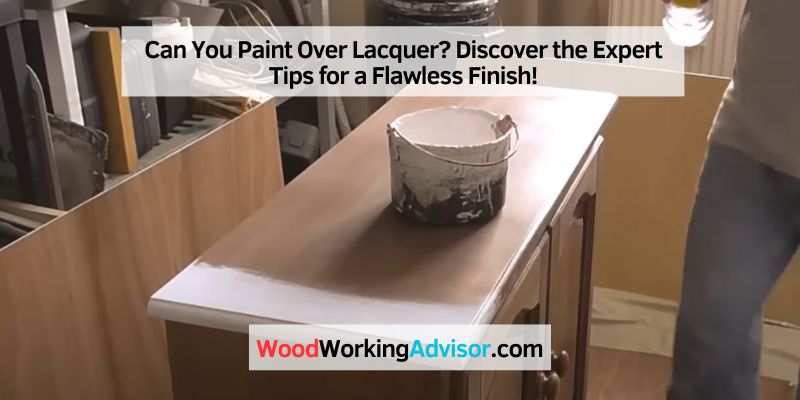Yes, you can paint over lacquer. We will explore the process and considerations involved in painting over lacquered surfaces, including the necessary preparation and the types of paint that work best for this task.
Whether you want to update the color of your lacquered furniture or give a fresh look to your lacquered cabinets, understanding how to paint over lacquer can help transform your space while maintaining the integrity and durability of the underlying surface.
By following the steps outlined in this guide, you can achieve professional-looking results and enjoy a beautifully painted finish on your lacquered items. Read on to learn more about painting over lacquer.
Understanding Lacquer
Lacquer is a popular and versatile finish that is used on various surfaces, including wood, metal, and even some types of plastic. It is known for its beauty and durability, making it a preferred choice for protecting and enhancing the appearance of furniture, cabinets, and other objects. In this section, we will dive deeper into understanding lacquer, exploring what it is, its properties, and the advantages and disadvantages associated with it.
What Is Lacquer?
Lacquer is a clear or colored coating that dries to form a hard, glossy finish. It is typically created by dissolving natural or synthetic resin in a solvent, which is then applied to the surface. As the solvent evaporates, the resin hardens, creating a protective layer that enhances the appearance and longevity of the object.
Properties Of Lacquer
Lacquer possesses several notable properties that contribute to its popularity in the world of finishes:
- High Gloss: Lacquer provides a brilliant, mirror-like shine that adds elegance and sophistication to any surface.
- Fast Drying: Lacquer has a quick drying time, allowing for efficient application and reduced waiting periods between coats.
- Excellent Clarity: Its transparent nature allows the natural beauty of the underlying material to shine through, making it ideal for showcasing wood grain or metal textures.
- Durable: Lacquer forms a tough and protective shell that resists scratches, impacts, and abrasions.
- Easy Repair: In the event of damage or wear, lacquer can be easily repaired by re-coating the affected area.
Advantages And Disadvantages Of Lacquer
Like any other finish, lacquer comes with its own set of advantages and disadvantages. Let’s take a closer look:
Advantages
- Enhanced Appearance: Lacquer elevates the visual appeal of surfaces, imparting a stunning glossy finish.
- Fast Application: Its quick-drying properties make lacquer an efficient choice for projects with tight timelines.
- Easy Maintenance: The protective layer of lacquer makes surfaces easy to clean and maintain, requiring minimal effort.
- Repairability: Lacquer can be easily touched up or recoated if damage occurs, extending the lifespan of the finish.
Disadvantages
- Vulnerability to Solvents: Lacquer may be susceptible to damage when exposed to certain solvents, so caution must be exercised when using harsh chemicals.
- Fading and Yellowing: Over time, some lacquer finishes may experience fading or yellowing, particularly when exposed to sunlight.
- Difficulty with Adhesion: Painting over lacquer can be challenging, as the smooth surface may require additional preparation to ensure proper adhesion.
Understanding the properties, advantages, and disadvantages of lacquer is crucial when deciding whether to paint over an existing lacquer finish. By having a comprehensive knowledge of lacquer, you can make an informed decision and achieve the desired results for your project.

Painting Over Lacquer
When it comes to updating the look of your furniture or cabinets, painting over lacquer can be a great option. However, it’s important to follow the right steps to ensure a smooth and long-lasting finish. In this guide, we’ll walk you through the preparation process, choosing the right paint, applying primer, and various painting techniques to help you achieve the best results. Let’s dive in!
Preparation
Before you start painting over lacquer, proper preparation is key to ensure the paint adheres well and gives you a professional finish. Here are the steps to follow:
- Begin by cleaning the surface with a mild soap and water solution to remove any dirt, grease, or grime. Rinse thoroughly and allow it to dry.
- Sand the lacquer lightly using fine-grit sandpaper. This helps create a rough surface for the new paint to grip, ensuring better adhesion.
- Remove any dust or debris using a tack cloth or a soft, lint-free cloth.
- Repair any imperfections such as dents or scratches using wood filler or putty. Sand the repaired areas smooth once they are dry.
Choosing The Right Paint
When it comes to painting over lacquer, choosing the right paint is crucial for a successful outcome. Here are a few things to consider:
- Opt for a high-quality paint specifically designed for the material you are painting, such as wood or metal.
- Look for paints that are labeled as “self-priming” or “all-in-one” to save time and effort.
- Consider the finish you desire. Matte, satin, or gloss finishes all have different visual effects and levels of durability.
- Ensure the paint you choose is compatible with lacquer and will adhere well to the surface.
Applying Primer
Priming the surface before painting is essential as it helps improve adhesion and allows the paint to go on smoothly. Follow these tips when applying primer:
- Choose a primer that is specifically formulated for use on lacquered surfaces.
- Apply the primer evenly using a brush or roller, following the manufacturer’s instructions regarding drying times and recoat intervals.
- Allow the primer to dry completely before moving on to the next step.
- Sand the primed surface lightly with fine-grit sandpaper to create a smooth surface for the paint.
Painting Techniques
Now that you have prepared the surface and applied primer, it’s time to start painting over the lacquer. Below are some painting techniques to help you achieve a professional-looking finish:
- Apply the paint in thin, even coats rather than one thick coat. This helps prevent drips and allows for better control.
- Use a brush or roller suited for the type of paint you are using. Nylon brushes are ideal for latex paint, while natural bristle brushes work well with oil-based paint.
- Allow each coat of paint to dry completely before applying the next one. Follow the manufacturer’s instructions regarding drying times.
- Sand lightly between coats with fine-grit sandpaper to smooth out any imperfections or brush marks.
Expert Tips For A Flawless Finish
Painting over lacquer can be a challenging task, especially if you want to achieve a flawless finish. However, with the right tips and techniques, you can successfully paint over lacquer and breathe new life into your furniture or surfaces. In this article, we will share expert tips to help you achieve a flawless finish when painting over lacquer.
Surface Preparation
Before you start painting, it is crucial to prepare the surface properly. Any existing lacquer or varnish must be removed using a paint stripper or sandpaper. Make sure the surface is clean, dry, and free from any dust, oil, or debris. This will create a smooth base for the paint to adhere to.
Sanding And Cleaning
A key step in preparing the surface is sanding. Use fine-grit sandpaper to gently roughen up the lacquer, as this will help the paint adhere better. After sanding, clean the surface using a damp cloth to remove any dust or residue. This will ensure a clean and smooth finish.
Choosing The Right Paintbrush Or Roller
The choice of paintbrush or roller is crucial for achieving a flawless finish. For smaller areas or intricate details, a high-quality synthetic bristle brush is recommended. This brush will provide better control and help you achieve a smooth and even application of paint. For larger surfaces, a high-density foam roller is ideal, as it will ensure an even coat of paint without leaving brush marks or streaks.
Painting In Thin Coats
When painting over lacquer, it is essential to apply multiple thin coats of paint rather than one thick coat. Thick coats can lead to uneven drying and may result in visible brush strokes or an uneven finish. Apply the paint in even strokes, allowing each coat to dry completely before applying the next one. This will help you achieve a flawless and professional-looking finish.
Allowing Sufficient Drying Time
Patience is key when it comes to painting over lacquer. Allow each coat of paint to dry fully before proceeding with the next coat or any additional steps. Rushing the drying process can result in a tacky or uneven finish. It is recommended to follow the drying time mentioned on the paint can for best results.
Applying A Protective Top Coat
To ensure a durable and long-lasting finish, it is important to apply a protective top coat. This will protect the paint from chips, scratches, and general wear and tear. Choose a clear polyurethane or varnish that is compatible with the paint you used. Apply the top coat in thin, even coats, following the manufacturer’s instructions and allowing sufficient drying time between each coat.
By following these expert tips for a flawless finish, you can confidently paint over lacquer and create a refreshed and beautiful surface that will stand the test of time. Be patient, pay attention to the details, and enjoy the process of transforming your furniture or surfaces with a fresh coat of paint.

Common Mistakes To Avoid
When painting over lacquer, it’s crucial to avoid making common mistakes that could ruin your project. Skipping surface preparation, using the wrong paint type, applying thick layers of paint, and rushing the drying process are all errors that can lead to less-than-desirable results. In this section, we’ll delve into these mistakes in more detail and explain why they should be avoided at all costs.
Skipping Surface Preparation
Skipping surface preparation is one of the biggest mistakes you can make when painting over lacquer. Surface prep involves cleaning the surface, removing any dirt, dust, or grime, and sanding it lightly to create a rough texture for better paint adhesion. By neglecting this step, the new paint may fail to stick properly, resulting in peeling, flaking, or premature wear. Take the time to prepare the surface thoroughly before painting for a smooth and durable finish.
Using The Wrong Paint Type
Using the wrong paint type is another mistake that can lead to disappointing results. Lacquer is a solvent-based coating, so it’s important to choose a paint that is compatible with it. Otherwise, the old lacquer may react with the new paint and cause bubbling, cracking, or other imperfections. It’s recommended to use a paint specifically designed for lacquer or consult with a paint specialist to ensure you choose the right type for your project.
Applying Thick Layers Of Paint
Applying thick layers of paint may seem like a shortcut to achieving full coverage, but it can actually cause problems. Thick paint layers take longer to dry, which can result in uneven drying or even surface damage. Additionally, excessive paint buildup can lead to cracking, wrinkling, or a “pulled” appearance. It’s best to apply multiple thin coats of paint, allowing each layer to dry thoroughly between applications, for a smooth and professional finish.
Rushing The Drying Process
Rushing the drying process is a common mistake made by impatience. It’s crucial to allow the paint to dry fully before handling or applying additional coats. Rushing can lead to smudging, smearing, or even removing the previous layers of paint. Be sure to follow the manufacturer’s instructions for drying time and avoid touching or disturbing the painted surface until it is completely dry. Patience is key to achieving exceptional and long-lasting results.
Conclusion
Painting over lacquer can be a challenging task, but with the right preparation and techniques, it is definitely doable. Remember to thoroughly clean and sand the surface before applying the new paint to ensure proper adhesion. It is also important to choose the right type of paint and primer for the job.
By following these steps, you can achieve a beautiful, long-lasting finish that will transform your lacquered surfaces. Happy painting!


